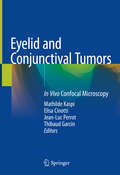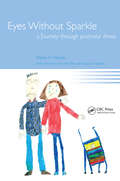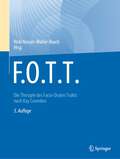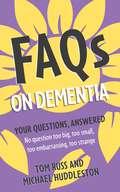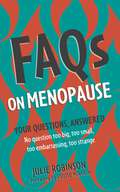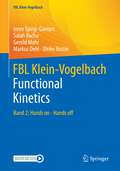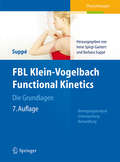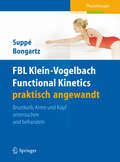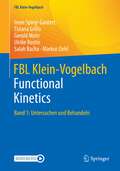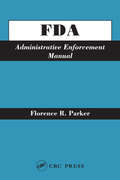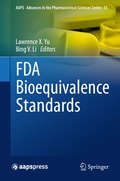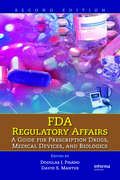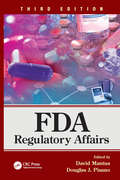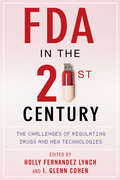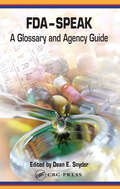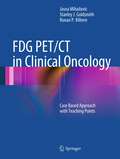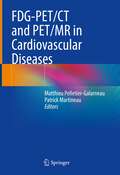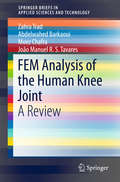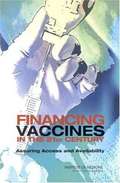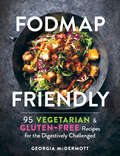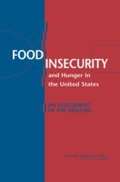- Table View
- List View
Eyelid and Conjunctival Tumors: In Vivo Confocal Microscopy
by Mathilde Kaspi Elisa Cinotti Jean-Luc Perrot Thibaud GarcinThis Atlas gives the complete expert opinion on the diagnostic features of eyelid and conjunctival tumors (benign and malignant): a state-of-the-art guide with numerous images, useful for both dermatologists and ophthalmologists. This invaluable resource, illustrating clinical, histological and re fectance confocal microscopy features, first addresses the normal conditions of the ocular surface, then reviews lesions due to epidermal, melanocytic and adnexal tumors. A final part is devoted to conjunctiva conditions, from normal to malignant conjunctival tumors. The high number of illustrations and their description of many ocular surface lesions with in vivo confocal microscopy make this atlas an essential guide for the practitioners of both specialities.
Eyes Without Sparkle: A Journey Through Postnatal Illness
by Elaine HanzakOne day you will feel better… Eyes without Sparkle is a powerful medical autobiography describing the journey followed by the author into, through, and out of puerperal psychosis, the most severe form of postnatal depression. With vivid and intimate descriptions of events and the author’s feelings, this is the only book offering a single first-hand account of postnatal illness. The book serves as an inspiration for anyone suffering from or involved with a depressive illness. For health and social care professionals it is a reflective guide to learning from patients’ experiences, and the examples of positive and negative aspects of treatment can inform mental health services and policies.
F.O.T.T.: Die Therapie des Facio-Oralen Trakts nach Kay Coombes
by Ricki Nusser-Müller-BuschDieses praxisnahe Standardwerk vermittelt das bewährte interprofessionelle Therapiekonzept F.O.T.T. nach Kay Coombes. Im Mittelpunkt stehen die individuelle Förderung und Teilhabe von Patient*innen mit Dysphagie und Störungen der Atmung, der Stimme, des Sprechens und des Gesichtsausdrucks sowie die therapeutische Mundhygiene bei Schwerbetroffenen. Alle praxisrelevanten Themen zu Atmung, Stimme, Schlucken, Trachealkanülen-Management, Nahrungsaufnahme, Mundhygiene sowie die Behandlung von Patienten mit Fazialisparese und Kindern mit Zerebralparesen sind ausführlich beschrieben und durch zahlreiche Abbildungen veranschaulicht. Die 5. Auflage wurde grundlegend überarbeitet. Das ideale Praxis- und Fachbuch für die Logopädie, Ergotherapie, Physiotherapie, Pflege sowie für Ärzt*innen, die professionell das F.O.T.T.-Konzept im interprofessionellen Team umsetzen möchten. Auch hilfreich für pflegende Angehörige.
FAQs on Dementia
by Tom Russ Michael HuddlestonYou left the doctor's surgery before you could ask the things you really wanted to know.You've googled your question about dementia and had 75 answers, all contradicting each other.You asked your best friend - but they looked at you strangely.You have so many questions, but no idea where to start finding the answers. Here they are. In this book you'll find the definitive, expert responses to all your FAQs: On Dementia. No question is too simple, too embarrassing, too rude or too offbeat to be included, and each one has been asked by thousands of people just like you.Will my partner stop loving me now they have dementia?Does my mum have to go into a home now?Is dementia a terminal illness?All these questions, and hundreds more, are covered in this short but powerful, helpful, practical guide to understanding the nature, and impact, of dementia. Read at your leisure, or dip in and out when you most need the support or to shine a light on the issues and concerns that are making you uncomfortable or unhappy, and to bring them out of the shadows so you can understand and accept them.
FAQs on Dementia
by Tom Russ Michael HuddlestonYou left the doctor's surgery before you could ask the things you really wanted to know.You've googled your question about dementia and had 75 answers, all contradicting each other.You asked your best friend - but they looked at you strangely.You have so many questions, but no idea where to start finding the answers. Here they are. In this book you'll find the definitive, expert responses to all your FAQs: On Dementia. No question is too simple, too embarrassing, too rude or too offbeat to be included, and each one has been asked by thousands of people just like you.Will my partner stop loving me now they have dementia?Does my mum have to go into a home now?Is dementia a terminal illness?All these questions, and hundreds more, are covered in this short but powerful, helpful, practical guide to understanding the nature, and impact, of dementia. Read at your leisure, or dip in and out when you most need the support or to shine a light on the issues and concerns that are making you uncomfortable or unhappy, and to bring them out of the shadows so you can understand and accept them.
FAQs on Menopause
by Julie Robinson- You left the doctor's surgery before you could ask the things you really wanted to know.- You've googled your question about menopause symptoms and had 75 answers, all contradicting each other.- You asked your best friend - but they looked at you strangely.You have so many questions, but no idea where to start finding the answers. Here they are. In this book you'll find the definitive, expert responses to all your FAQs: On Menopause. No question is too simple, too embarrassing, too rude or too offbeat to be included, and each one has been asked by thousands of people just like you.Do people know I'm having a hot flush?Is it normal to feel rage all the time?Why I am getting more hair in some places and losing it from others?All these questions, and hundreds more, are covered in this short but powerful, helpful, practical guide to managing your menopause symptoms. Read at your leisure, or dip in and out when you most need the support or to shine a light on the problems and feelings that are making you uncomfortable or unhappy, and to bring them out of the shadows so you can understand and accept them.
FAQs on Menopause
by Julie Robinson- You left the doctor's surgery before you could ask the things you really wanted to know.- You've googled your question about menopause symptoms and had 75 answers, all contradicting each other.- You asked your best friend - but they looked at you strangely.You have so many questions, but no idea where to start finding the answers. Here they are. In this book you'll find the definitive, expert responses to all your FAQs: On Menopause. No question is too simple, too embarrassing, too rude or too offbeat to be included, and each one has been asked by thousands of people just like you.Do people know I'm having a hot flush?Is it normal to feel rage all the time?Why I am getting more hair in some places and losing it from others?All these questions, and hundreds more, are covered in this short but powerful, helpful, practical guide to managing your menopause symptoms. Read at your leisure, or dip in and out when you most need the support or to shine a light on the problems and feelings that are making you uncomfortable or unhappy, and to bring them out of the shadows so you can understand and accept them.
FBL Klein Vogelbach Functional Kinetics: Band 2: Hands on - Hands off (FBL Klein-Vogelbach)
by Irene Spirgi-Gantert Gerold Mohr Markus Oehl Salah Bacha Ulrike RostinDie vier bewährten Lehr- und Praxisbücher der Funktionellen Bewegungslehre zu Grundlagen, therapeutischen Übungen, Ballübungen und Behandlungstechniken kompakt in zwei Bänden zusammengefasst! Mit Band 1 „Untersuchen und Behandeln“ und Band 2 „Hands on – Hands off“ sind Sie perfekt gerüstet! Physiotherapeuten finden in Band 2 die Prinzipien zu allen wesentlichen Techniken und Übungen der Funktionellen Bewegungslehre, über 40 Übungen und neue funktionelle Tests für das Überprüfen von Mobilität, Elastizität, Stabilität, Bewegungsdissoziation und Koordination. Wie sieht der klinische Denk- und Entscheidungsprozess von Hands-on zu Hands-off aus? Wie muss das funktionelle Training aufgebaut werden, damit ein müheloser Transfer in den Alltag gelingt? Welche Bewegungschoreografien fördern die Interaktion der Körperabschnitte untereinander optimal? Erfahrene FBL-Instruktoren beantworten Ihnen diese Fragen! Aus dem Inhalt · Grundparameter der Bewegungsökonomie · Neurofunktionelle Tests · Mobilisierende Massage, hubfreie und widerlagernde Mobilisation und funktionelle Übungen mit und ohne Ball · Training von Bewegungskontrolle und Geschicklichkeit aller Körperabschnitte Plus: Videos und Handouts veranschaulichen die praktische Umsetzung optimal! Nutzen Sie die bewährten und ständig weiterentwickelten Methoden der FBL und lernen Sie, die körperlichen Ressourcen Ihrer Patienten optimal zu fordern und zu fördern.
FBL Klein-Vogelbach Functional Kinetics Die Grundlagen
by Irene Spirgi-Gantert Barbara SuppéVon B. Werbeck und I. Spirgi-Gantert völlig neu bearbeitet und inhaltlich wie formal rundum modernisiert: - besser lesbar und leichter zugänglich - mit farbigen Lernhilfen und Zeichnungen - praxisbezogen durch zahlreiche Beispiele - Neu: Grundlagen der Gangschulung und Ausblicke auf Behandlungstechniken und Übungen Als Standardwerk in der Physiotherapie leitet es Therapeuten in der Ausbildung an, o normale und von der Norm abweichende Bewegung und Haltung präzise zu beobachten, o dem Patienten in der Behandlung richtiges Bewegungsverhalten zu vermitteln und o seine aktive Wahrnehmung dafür zu schulen.
FBL Klein-Vogelbach Functional Kinetics Die Grundlagen: Bewegungsanalyse, Untersuchung, Behandlung
by Barbara SuppéVon B. Werbeck und I. Spirgi-Gantert völlig neu bearbeitet und inhaltlich wie formal rundum modernisiert:- besser lesbar und leichter zugänglich- mit farbigen Lernhilfen und Zeichnungen- praxisbezogen durch zahlreiche Beispiele- Neu: Grundlagen der Gangschulung und Ausblicke auf Behandlungstechniken und ÜbungenAls Standardwerk in der Physiotherapie leitet es Therapeuten in der Ausbildung an,o normale und von der Norm abweichende Bewegung und Haltung präzise zu beobachten,o dem Patienten in der Behandlung richtiges Bewegungsverhalten zu vermitteln undo seine aktive Wahrnehmung dafür zu schulen.
FBL Klein-Vogelbach Functional Kinetics praktisch angewandt: Brustkorb, Arme und Kopf untersuchen und behandeln
by Barbara Suppé Matthias BongartzIn der Buchreihe wird detailliert dargestellt, wie die Übungen und Behandlungstechniken der FBL/Functional Kinetics an und mit den Patienten angewandt werden können. Diese "Gebrauchsanleitung" für die Arbeit mit dem FBL-Instrumentarium gliedert sich jeweils in Untersuchung und problemorientierte Behandlung. Jeder der drei Bände thematisiert die Körperabschnitte, die als funktionelle Einheiten betrachtet und therapiert werden, bzw. therapierelevante Bewegungsabläufe: Becken und Beine (1); Brustkorb, Arme, Kopf (2); Gehen, Sitzen, Bücken (3).
FBL Klein-Vogelbach Functional Kinetics: Band 1: Untersuchen und Behandeln (FBL Klein-Vogelbach)
by Irene Spirgi-Gantert Gerold Mohr Markus Oehl Tiziana Grillo Salah Bacha Ulrike RostinDie vier bewährten Lehr- und Praxisbücher der Funktionellen Bewegungslehre zu Grundlagen, therapeutischen Übungen, Ballübungen und Behandlungstechniken kompakt in zwei Bänden zusammengefasst! Mit „Untersuchen und Behandeln“ und „Hands on – Hands off“ sind Sie perfekt gerüstet! Dieses Buch liefert Physiotherapeuten die Grundlagen und alle wesentlichen Techniken der Funktionellen Bewegungslehre. Welchen Einfluss hat die Schwerkraft auf Haltung und Bewegung? Welche Bewegungen des täglichen Lebens sollten während des Befundes überprüft werden? Und wie genau funktioniert eigentlich der „Flamingo“? Die Experten beantworten Ihnen diese Fragen! Aus dem Inhalt· Basics zu Myofaszien, Bewegung, Haltung und motorischem Lernen· Untersuchung, u.a. mit Blick auf Konstitution, Beweglichkeit, Statik und ADL· Mobilisierende Massage, hubfreie und widerlagernde Mobilisation und funktionelle Übungen mit und ohne Ball Plus: Videos und Handouts veranschaulichen die praktische Umsetzung optimal! Nutzen Sie die bewährten und ständig weiterentwickelten Methoden der FBL und lernen Sie, die körperlichen Ressourcen Ihrer Patienten optimal zu fordern und zu fördern.
FDA Administrative Enforcement Manual
by Florence R. ParkerWhen a problem arises with a product regulated by FDA, the Agency can take a number of actions to protect the public health. Initially, the agency works with the manufacturer to correct the problem voluntarily. If that fails, administrative enforcement and legal remedies include asking the manufacturer to recall a product and having federal marshal
FDA Bioequivalence Standards
by Lawrence X. Yu Bing V. LiThis comprehensive reference provides an in-depth discussion on state-of-the-art regulatory science in bioequivalence. In sixteen chapters, the volume explores a broad range of topics pertaining to bioequivalence, including its origin and principles, statistical considerations, food effect studies, conditions for waivers of bioequivalence studies, Biopharmaceutics Classification Systems, Biopharmaceutics Drug Disposition Classification System, bioequivalence modeling/simulation and best practices in bioanalysis. It also discusses bioequivalence studies with pharmacodynamic and clinical endpoints as well as bioequivalence approaches for highly variable drugs, narrow therapeutic index drugs, liposomes, locally acting gastrointestinal drug products, topical products and nasal and inhalation products. FDA Bioequivalence Standards is written by FDA regulatory scientists who develop regulatory policies and conduct regulatory assessment of bioequivalence. As such, both practical case studies and fundamental science are highlighted in these chapters. The book is a valuable resource for scientists who work in the pharmaceutical industry, regulatory agencies and academia as well as undergraduate and graduate students looking to expand their knowledge about bioequivalence standards.
FDA Regulatory Affairs: A Guide for Prescription Drugs, Medical Devices, and Biologics
by Douglas J. Pisano David S. MantusExamines harmonization of the US Federal Food, Drug, and Cosmetic Act with international regulations as they apply to human drug and device development, research, manufacturing, and marketing. The Second Edition focuses on the new drug approval process, cGMPs, GCPs, quality system compliance, and corresponding documentation requirements. Written in
FDA Regulatory Affairs: Third Edition
by David Mantus Douglas J. PisanoFDA Regulatory Affairs is a roadmap to prescription drug, biologics, and medical device development in the United States. Written in plain English, the concise and jargon-free text demystifies the inner workings of the US Food and Drug Administration (FDA) and facilitates an understanding of how the agency operates with respect to compliance and product approval, including clinical trial exemptions, fast track status, advisory committee procedures, and more.The Third Edition of this highly successful publication: Examines the harmonization of the US Federal Food, Drug, and Cosmetic Act with international regulations on human drug, biologics and device development, research, manufacturing, and marketing Includes contributions from experts at organizations such as the FDA, National Institutes of Health (NIH), and PAREXEL Focuses on the new drug application (NDA) process, cGMPs, GCPs, quality system compliance, and corresponding documentation requirements Provides updates to the FDA Safety and Innovation Act (FDASIA), incorporating pediatric guidelines and follow-on biologics regulations from the 2012 Prescription Drug User Fee Act (PDUFA) V Explains current FDA inspection processes, enforcement options, and how to handle FDA meetings and required submissions Co-edited by an industry leader (Mantus) and a respected academic (Pisano), FDA Regulatory Affairs, Third Edition delivers a compilation of the selected US laws and regulations as well as a straightforward commentary on the FDA product approval process that’s broadly useful to both business and academia.
FDA in the Twenty-First Century: The Challenges of Regulating Drugs and New Technologies
by Cohen Lynch Holly Fernandez I. GlennIn its decades-long effort to assure the safety, efficacy, and security of medicines and other products, the Food and Drug Administration has struggled with issues of funding, proper associations with industry, and the balance between consumer choice and consumer protection. Today, these challenges are compounded by the pressures of globalization, the introduction of novel technologies, and fast-evolving threats to public health. With essays by leading scholars and government and private-industry experts, FDA in the Twenty-First Century addresses perennial and new problems and the improvements the agency can make to better serve the public good.The collection features essays on effective regulation in an era of globalization, consumer empowerment, and comparative effectiveness, as well as questions of data transparency, conflicts of interest, industry responsibility, and innovation policy, all with an emphasis on pharmaceuticals. The book also intervenes in the debate over off-label drug marketing and the proper role of the FDA before and after a drug goes on the market. Dealing honestly and thoroughly with the FDA's successes and failures, these essays rethink the structure, function, and future of the agency and the effect policy innovations may have on regulatory institutions abroad.
FDA-Speak: A Glossary and Agency Guide
by Dean E. SnyderOften thought of as a subdialect of American "governmentese," FDA-Speak is a language unique to healthcare regulators and those regulated. If you have any involvement with the US Food and Drug Administration, or if they have involvement with you, you need to speak the language. This revised and updated edition of FDA-Speak retains the original easy
FDG PET/CT in Clinical Oncology
by Stanley J. Goldsmith Jasna Mihailovic Ronan P. KilleenFDG PET/CT has rapidly emerged as an invaluable combined imaging modality that provides both anatomic and functional information. This book, comprising a collection of images from oncology cases, is organized according to the role of FDG PET/CT in the evaluation and management of oncology patients, and only secondarily by organ or tumor entity. In this way, it reflects the issues that clinicians actually address, namely: identification of an unknown or unsuspected primary; determination of the extent of disease; evaluation of response to therapy; and surveillance after response, i.e., detection of recurrent disease. In total, 100 cases involving different primary tumors are presented to illustrate findings in these different circumstances. FDG PET/CT in Clinical Oncology will be of great value to all newcomers to this field, whether medical students, radiology, nuclear medicine, or oncology fellows, or practicing physicians.
FDG-PET/CT and PET/MR in Cardiovascular Diseases
by Matthieu Pelletier-Galarneau Patrick MartineauThis book is a clinically oriented, up-to-date, and in-depth review of the various applications of FDG-PET/CT and PET/MR in cardiovascular diseases with emphasis on the current available evidence. Positron emission tomography (PET) imaging with fluorodeoxyglucose (FDG) has seen increased applications in cardiovascular diseases over the last decades. Its utility is already established in a wide range of conditions, including myocardial viability imaging, assessment of inflammatory diseases such as sarcoidosis and vasculitis, as well as imaging of infectious processes, such as infective endocarditis and cardiac implantable electronic device infection. In addition, there are several emerging indications such as the imaging of left ventricular assisting device infection and native valve endocarditis as well as new applications under investigation.The first section of the book reviews the technical basis of cardiovascular PET/CT and PET/MR imaging as well as cardiac metabolism. The following chapters each present specific pathologies, presenting epidemiology, pathophysiology, and diagnostic strategies, along with high quality clinical cases to support the discussion. The final chapter is a review of 15 interesting and clinically relevant cases.This is an ideal guide for nuclear medicine physicians, cardiologists, radiologists, residents, post-graduate fellows, and technologists.
FEM Analysis of the Human Knee Joint: A Review (SpringerBriefs in Applied Sciences and Technology)
by João Manuel R.S. Tavares Zahra Trad Abdelwahed Barkaoui Moez ChafraIn recent years, numerous scientific investigations have studied the anatomical, biomechanical and functional role of structures involved in the human knee joint. The Finite Element Method (FEM) has been seen as an interesting tool to study and simulate biosystems. It has been extensively used to analyse the knee joint and various types of knee diseases and rehabilitation procedures such as the High Tibial Osteotomy (HTO). This work presents a review on FEM analysis of the human knee joint and HTO knee surgery, and discusses how adequate this computational tool is for this type of biomedical applications. Hence, various studies addressing the knee joint based on Finite Element Analysis (FEA) are reviewed, and an overview of clinical and biomechanical studies on the optimization of the correction angle of the postoperative knee surgery is provided.
FINANCING VACCINES IN THE 21ST CENTURY: Assuring Access and Availability
by Committee on the Evaluation of Vaccine Purchase Financing in the United StatesThe national immunization system has achieved high levels of immunization, particularly for children. However, this system faces difficult challenges for the future. Significant disparities remain in assuring access to recommended vaccines across geographic and demographic populations. These disparities result, in part, from fragmented public–private financing in which a large number of children and adults face limited access to immunization services. Access for adults lags well behind that of children, and rates of immunizations for those who are especially vulnerable because of chronic health conditions such as diabetes or heart and lung disease, remain low. Financing Vaccines in the 21st Century: Assuring Access and Availability addresses these challenges by proposing new strategies for assuring access to vaccines and sustaining the supply of current and future vaccines. The book recommends changes to the Advisory Committee on Immunization Practices (ACIP)-the entity that currently recommends vaccines-and calls for a series of public meetings, a post-implementation evaluation study, and development of a research agenda to facilitate implementation of the plan.
FND Stories: Personal and Professional Experiences of Functional Neurological Disorder
by Gregg H. Rawlings, Markus Reuber, Jon Stone and Maxanne McCormickFunctional Neurological Disorder (FND) is one of the most common diagnoses among patients referred to neurology clinics, but is still misunderstood and under-recognised by medical professionals and the public. This vital book brings together the voices of healthcare professionals and people living with FND across the world. Experts in neurology provide a clear, evidence-based explanation of FND as an introduction, laying the foundation for the personal stories of people with FND and the professionals involved in their care. From testing and diagnosis to dealing with stigma and coping with changing symptoms, each chapter delves into the realities of life with FND from the perspective of lived experience. FND can be an isolating condition. The life stories in this book will help you to make sense of living with FND and tackle its challenges alongside others with the condition.
FODMAP Friendly: 95 Vegetarian And Gluten-free Recipes For The Digestively Challenged
by Georgia McDermottThis is the low-FODMAP cookbook vegetarians have been waiting for. It’s tough when the foods you love don’t love you back. If you’re dealing with digestive issues, cutting out high-FODMAP foods can bring relief—but it’s hard to say goodbye to wheat, dairy, and many fruits and veggies. And if you’re vegetarian or vegan and going low-FODMAP? It can be even harder to fill your plate! Georgia McDermott comes to the rescue in FODMAP Friendly, with 95 vegetarian, vegan-friendly, and gluten-free recipes for the digestively challenged. Her delicious, low- to no-FODMAP fare covers all the bases: Lighter meals and breakfasts, like Grain-Free Olive Oil Granola and Roasted Pepper and Halloumi Shakshuka Hearty dinners, from Tempeh Chili to Pepper, Pesto, and Goat Cheese Galette Delectable desserts—Pavlova with Roasted Lemony Strawberries, anyone? Festive food and drinks for a crowd, including Salted Honey and Sage Baked Camembert and Passion Fruit Caipirinhas FODMAP sensitivity varies from person to person, so Georgia includes a wealth of suggestions for exploring what does and doesn’t work for you. Onion and garlic don’t bother you? Add them! The thought of tomatoes turns you off? Don’t eat them! Living with IBS, Crohn’s disease, colitis, SIBO—you name it—shouldn’t mean needlessly missing out on the flavors you crave. This is low-FODMAP eating—made friendly for everyone.
FOOD INSECURITY and Hunger in the United States: AN ASSESSMENT OF THE MEASURE
by National Research Council of the National AcademiesThe National Academies Press (NAP)--publisher for the National Academies--publishes more than 200 books a year offering the most authoritative views, definitive information, and groundbreaking recommendations on a wide range of topics in science, engineering, and health. Our books are unique in that they are authored by the nation's leading experts in every scientific field.
